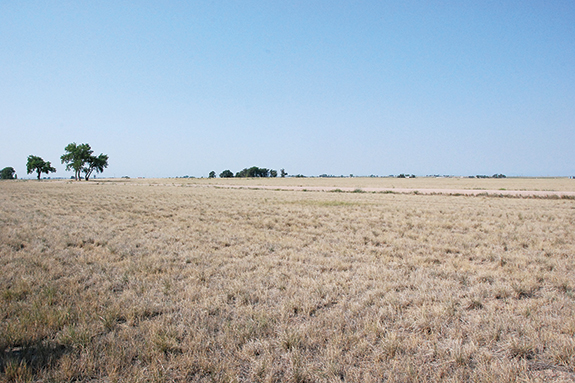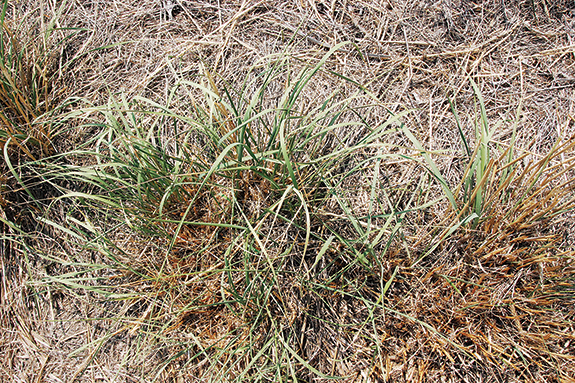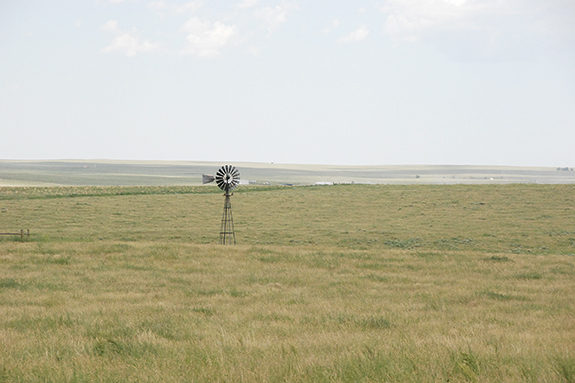Unless you can tell what the future will bring and know how long and how severe the drought will be, you should always be planning and managing for drought.
In a long, severe drought there is a high risk of plant mortality on a large scale, followed by soil erosion. With soil loss, it can take decades to return the soil to pre-drought health and establish or re-establish healthy forage plants.
During drought, the reduction of soil moisture reduces plants’ abilities to absorb and utilize nutrients and severely reduces plant growth both above ground and below ground.
Plants are not able to replace roots that normally are lost in regeneration or store needed energy reserves. As roots decrease in mass and health, the plant’s ability to produce vegetation is also reduced.
Fewer leaves mean photosynthesis is reduced, causing a reduction of forage production and carbohydrate storage for basic life-support functions.

During drought, plants are stressed and more susceptible to poor grazing management decisions.
The implications and results of grazing management mistakes during drought are extremely serious.
As time goes on and drought persists, management is a matter of keeping your livestock numbers in balance with available forage without impairing the forage plant’s ability to survive the drought.
The strategy is to utilize forage resources without impairing the forage plant’s ability to survive. Estimating the forage production amount for the season is critical in keeping forage supply and demand balanced.
Monitoring precipitation levels as a percentage of long-term median precipitation during spring months (April, May and June) is a good way to estimate forage production during summer’s growing season.
So if you receive 60 percent of the long-term median, you can expect approximately 60 percent of the forage you would get in a “normal” year.
Learning to clip, dry-weigh and calculate forage production can help you utilize pastures while maintaining their health. These methods can be used in good-condition years as well as drought years.
Once you have estimated your forage resources for the season, you then begin the decision-making process to balance forage demand.
Choices you have involve either adjusting the number of animals and amount of time they are on pasture or increasing your forage or feed resources. Reducing livestock numbers must include the possibility of de-stocking entirely (during extreme drought).
If you choose to graze during drought, your goal should be to manage grazing in a manner that sustains plants until the drought breaks.

The concept is to be conservative in the degree of forage utilization and pay attention to timing of grazing during the growing season.
Remember that well-managed pastures will recover much more quickly following drought than pastures that are not as well managed.
Plants that are lightly to moderately grazed will recover from drought more quickly than those that have been heavily utilized for years.
Stressed plants initiate growth later in the year and grow slower in the spring than those not stressed. During drought, plan on turning livestock out later and supplemental feeding longer in the spring.
Resist the temptation to over-utilize grasses during drought. You may buy a little time and forage, but you are likely only delaying the inevitable for a short while. The main drawback is a much longer recovery period following drought and possibly decades of recovery from the loss of forage plants.
Even in shorter or “minor” droughts, you will need to pay attention to the same principles of lighter or moderate utilization, later spring turn-out and supplemental feeding.
In rotational systems, plan on moving more frequently (less time in each pasture) and allowing longer recovery times. Light to moderate utilization is the key to forage plant survival.
Expect more weed pressure during and immediately following drought. Following drought, weeds respond much more quickly when precipitation is received, and the lack of competition from forage plants as they recover allows weeds to flourish.
Weed control during drought may not be a high priority. Drought conditions mean lower weed production, and the problems they present may not be serious. Weeds can contribute significantly to your overall forage resources as well.
If you do use herbicides for weed control during drought, be aware that many weeds produce a thicker cuticle, which reduces herbicide absorption.
The temptation is to increase the herbicide application rate, but this is not a wise decision. Increased herbicide application rates increase the possibility of damage to non-target vegetation, such as your forage plants. Once the drought has broken, you can consider resuming weed management.
With reduced forage, animals are tempted to graze plants they might not normally eat. This includes poisonous plants such as locoweed and larkspur, which may be green when pasture grasses are brown. Closely monitor pastures for poisonous plants.
Winter grazing
Winter-grazing techniques should follow the same guidelines as growing-season guidelines. Only allow animals access as long as there is vegetation above what is needed to protect the soil and plant crowns. Always leave some stubble to protect the grass crowns, help hold moisture and protect from soil erosion.
Stop winter grazing when you see new growth beginning to emerge or when most of the dried forage is utilized but while there is still stubble remaining (a minimum height of 4 inches remaining).
Preserving vegetation (stubble) helps to protect the buds for the next year’s growth.
Stubble also helps shade the soil and preserve what soil moisture there is. Keeping some stubble will also shade the soil to help prevent weed seed germination.
The more time you spend learning to protect and improve the health of your pasture grasses, the longer your grasses will survive and thrive in both good and drought years. FG
References omitted due to space but are available upon request. Click here to email an editor.
PHOTOS
PHOTO 1: Eastern Colorado rangeland shows late-season grass regrowth .
PHOTO 2: Leaving stubble will help protect grass crowns and hold moisture to protect from soil erosion.
PHOTO 3: Grazing should be curtailed or stopped when late-season growth begins to emerge. Photos courtesy of Sharon Bokan.
Sharon Bokan
Small Acreage Coordinator
Colorado State University Extension Boulder County








